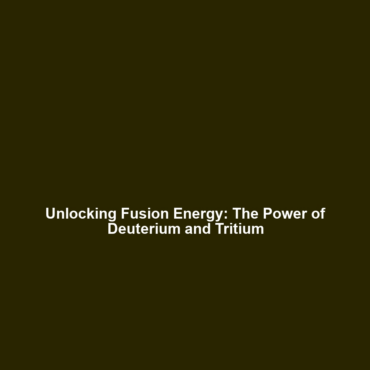ITER and Its Role in Advancing Fusion Energy
Introduction
Fusion energy represents a frontier in renewable energy technology, aiming to harness the same processes that power the sun. The International Thermonuclear Experimental Reactor (ITER) is at the forefront of this endeavor, with objectives centered on demonstrating the feasibility of fusion energy on a large scale. This initiative is crucial for ensuring sustainable energy for future generations. By successfully conducting experiments that bring us closer to controllable and thermonuclear fusion, ITER will pave the way for commercial fusion reactors, which could revolutionize the energy sector.
Key Concepts
Understanding the framework of ITER requires comprehending core scientific principles associated with fusion energy:
-
Nuclear Fusion
– The process of combining lighter atomic nuclei, such as hydrogen isotopes, to form heavier nuclei and release energy.
-
Plasma Physics
– The study of plasma, a state of matter critical for sustaining fusion reactions.
-
Tokamak Design
– A doughnut-shaped magnetic confinement device employed in ITER to control plasma behavior and optimize fusion conditions.
Together, these concepts highlight ITER’s role in advancing our understanding of Fusion Energy, making it a pivotal step towards large-scale application.
Applications and Real-World Uses
The implications of ITER extend beyond theoretical research into practical applications:
- Power Generation: Once operational, ITER aims to demonstrate how fusion can provide a near-limitless supply of energy with minimal environmental impact.
- Medical Isotope Production: Fusion reactors may help create isotopes used in medical applications, enhancing diagnostic and treatment technologies.
- Hydrogen Production: Potential for scalable hydrogen production as a clean energy carrier derived from fusion processes.
These applications of ITER in the field of Fusion Energy underscore its significance for future energy solutions.
Current Challenges
Despite its promise, several challenges impede the realization of ITER’s goals, including:
- Technical Complexities: Building and maintaining a functional fusion reactor is an engineering challenge fraught with uncertainties.
- Financial Constraints: The multi-billion dollar budget necessitates international collaboration and steady funding.
- Public Perception: Misconceptions about safety and environmental impact can hinder public support for fusion initiatives.
Addressing these issues in the realm of Fusion Energy is critical for the successful implementation of the ITER project.
Future Research and Innovations
Advancements in technology will likely shape the future of fusion energy significantly. Upcoming innovations include:
- Advanced Materials: Research into new materials capable of withstanding the extreme conditions within fusion reactors.
- Better Magnetic Confinement: Developing novel confinement techniques to enhance plasma stability and reduce energy loss.
- Integrated Fuel Systems: Innovations in fuel cycle processes to optimize fusion reactions for better energy output.
These future-oriented research efforts will play a pivotal role in determining the feasibility of commercial fusion energy.
Conclusion
In summary, ITER aims to demonstrate that fusion energy can be feasible on a large scale, a vital step towards commercial reactors. The significance of this endeavor cannot be overstated, as it holds the potential to address pressing energy challenges worldwide. Continued investment in fusion research will not only enhance our understanding of this powerful energy source but could also lead to transformative advancements in energy technology. For more information on fusion energy developments, visit our Fusion Energy Research page.









